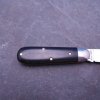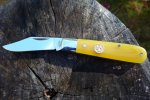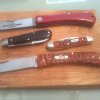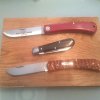glocktenman
Gold Member
- Joined
- Jul 20, 2008
- Messages
- 2,027
I was reading an article about a GEC Small Jack #25 w/ ebony wood handles. Dated Sept 22, 2016. Author listed is Tony Sculimbrene.
The author writes "But it is not QUITE in that top tier. For example, the bolts on the handle scales on by Canal Street Cutlery Boy's Knife are 100% flush. Not just flush, but fingernail flush. Without looking you could never tell where the brass pin ends and the G10 begins. Not so here. In fact, two of the bolts seem to stand out from the handle, maybe even on purpose."
Looking at two GEC 38s I own, I see four pins. One lower center pin holds the handle, liner and spring in place. Three others keep the handle and the liner together. The one with jigged bone handle has the pins flush or very close to flush with the handle material. The other with shaped micarta has the bottom center pin smoth with the shaped material. The pins on the ends are flush and the top center pin is inset.
My first thought was that the author wasn't very keen about traditional knives and their making and was identifying an issue that in fact, was not an issue with the knife. My second though was that my understanding of the pin depth in the handle material was wrong.
Are the pins not set based upon the handle material and any shaping the handles may require?
I'm including the picture of the #25 and the related Canal Street knife from the article.
What do you all think?


The author writes "But it is not QUITE in that top tier. For example, the bolts on the handle scales on by Canal Street Cutlery Boy's Knife are 100% flush. Not just flush, but fingernail flush. Without looking you could never tell where the brass pin ends and the G10 begins. Not so here. In fact, two of the bolts seem to stand out from the handle, maybe even on purpose."
Looking at two GEC 38s I own, I see four pins. One lower center pin holds the handle, liner and spring in place. Three others keep the handle and the liner together. The one with jigged bone handle has the pins flush or very close to flush with the handle material. The other with shaped micarta has the bottom center pin smoth with the shaped material. The pins on the ends are flush and the top center pin is inset.
My first thought was that the author wasn't very keen about traditional knives and their making and was identifying an issue that in fact, was not an issue with the knife. My second though was that my understanding of the pin depth in the handle material was wrong.
Are the pins not set based upon the handle material and any shaping the handles may require?
I'm including the picture of the #25 and the related Canal Street knife from the article.
What do you all think?








